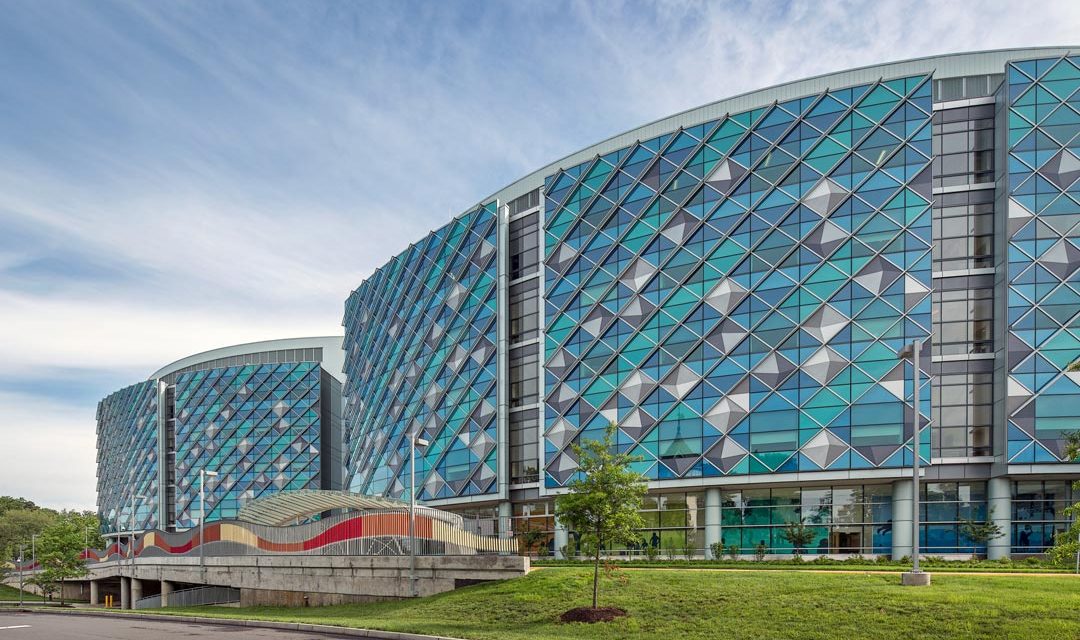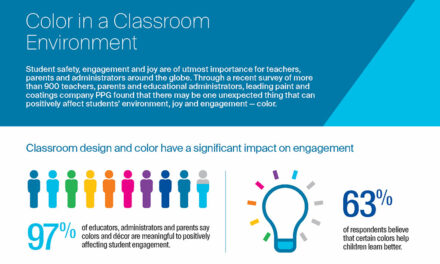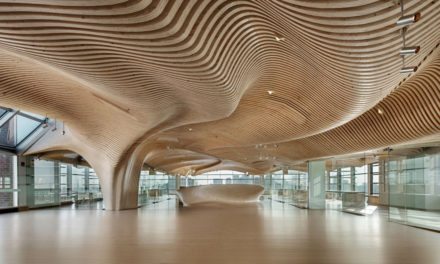When Paul Asteris of FKP Architects first conceived the signature façade of the newly expanded Nemours/Alfred I. duPont Hospital for Children, his vision was to have the glass and metal framing mimic the protective framework of an arbor. The use of Duranar Sunstorm coatings by PPG combined with his by-chance discovery of Azuria glass by Vitro Glass helped make that idea a reality.
Nemours/Alfred I. duPont Hospital for Children
Owner: Nemours Foundation, Jacksonville, Florida
Architect: FKP Architects, Houston
Vitro Architectural Glass (formerly PPG Glass) Products: SOLARBAN ® 70XL Glass, AZURIA® Glass
PPG Products: DURANAR ® SUNSTORM ® Coatings, Duranar XL Coatings
Glass/Curtain Wall Fabricator: Cristacurva, Houston and Oldcastle BuildingEnvelope®, Terrell, Texas
Coatings Applicator: Spectrum Metal Finishing
Glazing Contractor: R.A. Kennedy & Sons, Aston, Pennsylvania
Located in Wilmington, Delaware, Nemours/duPont hospital has undergone a series of expansions since its founding in the 1940s. The latest, a 450,000 square-foot addition, was designed to maintain the facility’s legacy of world-class treatment by drawing on the latest principles in health care design, including cozy, child-friendly patient rooms; welcoming, amenity-filled spaces for families and caregivers; healing gardens and large, open areas filled with abundant natural light.
As lead architect for the project, Asteris sought to appropriate the “playful elegance” of the gardens surrounding the neighboring duPont family mansion by placing a vast atrium at the center of the hospital and designing a bright arbor-patterned curtain wall for the exterior façade.
A combination of glass and metal coatings, including Solarban 70XL glass by Vitro Glass and Duranar XL and Duranar Sunstorm coatings by PPG, together with a timely recommendation for tinted Azuria glass, not only helped him achieve those aims, but enabled the project to stay on schedule too.
“The glass we were originally looking at [for the façade] had a blue/gray tint and was coming off a bit flat,” Asteris said. “By chance, a PPG [now Vitro Glass] representative visiting our office saw the renderings and offered to help with some samples. He came back using Azuria [glass] with some spandrel tones and it had the color punch we were looking for. That really helped us get the project back on track, as we were in danger of disrupting the schedule.”
The aqua-blue appearance of Azuria glass is complemented throughout the hospital by tall panels of clear Solarban 70XL glass and in the skylights that top the soaring central atrium. The goal with both products was to bring as much daylight as possible into occupied spaces.
“We believe this is a critical mission for the hospitals we design,” Asteris said. “Numerous studies confirm that natural light is conducive to creating learning and healing environments. “To us, this just seems like common sense.”
The jewel-like glitter of the hospital exterior is further enhanced by the application of Duranar XL and Duranar Sunstorm coatings. As two-component fluoropolymer coatings flecked with mica, Duranar Sunstorm coatings bring understated brilliance and exceptional durability to the metal framing on the main curtain wall. Three-component Duranar XL coatings in a custom “Seafoam Green” finish the metal panels that surround the emergency room entrance.
The fluoropolymer resins in Duranar coatings are chemically inert, which enables them to provide decades of color and gloss retention, as well as long-term resistance to environmental stresses such as acid rain and ultraviolet light.
The curtain wall also is integral to the energy management system, which was designed to help the hospital achieve LEED® (Leadership in Energy and Environmental Design) certification at the Silver level. “We chose glass products that would meet the current energy code then improve it by 10 percent,” Asteris explained.
Solarban 70XL glass, which features Vitro Glass’s proprietary triple-silver coating technology, has visible light transmittance (VLT) of 64 percent and a solar heat gain coefficient (SHGC) of 0.27 when combined with clear glass in a standard 1-inch insulating glass unit (IGU). The resulting 2.37 light-to-solar gain (LSG) ratio makes it one of the highest-performing products in the industry.
Even with its rich aqua-blue color, Azuria glass has a similar VLT of 61 percent in the same configuration, along with a SHGC of 0.39. Together, they yield an LSG ratio of 1.56, which is extraordinary for a tinted glass.
Solar tubes and the strategic placement of fritting on the glass façade alleviate the heat and glare of direct sunlight during the summer and channel light deeply into patient rooms to make them feel more spacious. Other green- related components in the hospital include water retention systems, roof gardens and enhanced mechanical systems.
To date, the feedback Asteris has received on the hospital’s design and performance has been universally positive. “The intent was to create a facility that would set Nemours apart from other children’s hospitals. The administration wanted this to be a place where families could bring their kids to get the best care available, so we needed to create spaces that would foster a family-friendly healing environment. Anyone who visits the hospital will sense that truly is the case.”
To learn more about Azuria glass and Solarban 70XL glass, visit www.vitroglazings.com or call 1-855-887-6457. To learn more about Duranar XL and Duranar Sunstorm coatings, visit www.ppgideascapes.com or call 1-888-PPG-IDEA (774-4332).
© 2016 Vitro Architectural Glass. All rights reserved. Azuria, Solarban and Sunstorm are registered trademarks owned by Vitro and their subsidiaries.
© 2016 PPG Industries, Inc. All rights reserved. IdeaScapes is a trademark and Duranar and the PPG logo are registered trademarks of PPG Industries Ohio, Inc.
LEED – an acronym for Leadership in Energy and Environmental Design® – is a registered trademark of the U.S. Green Building Council®.





